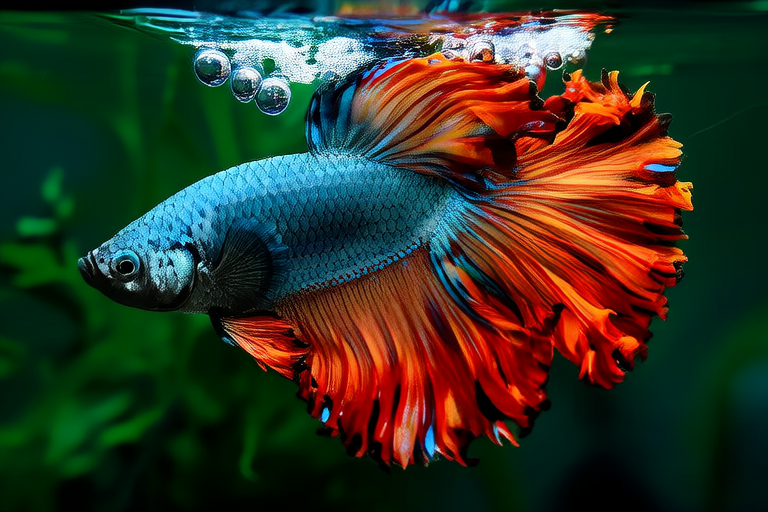From Bubble Nesting to Breeding: A Deep Dive into Betta Mating Habits
Betta fish, often referred to as Siamese fighting fish, are among the most popular aquarium pets. Known for their vibrant colors and flowing fins, these freshwater fish have a rich history of being bred for their physical characteristics. However, what makes bettas truly fascinating is their complex mating behavior, which includes the construction of bubble nests and intricate courtship rituals. Understanding these behaviors is crucial for responsible pet ownership and can contribute to conservation efforts.
The Unique Habitat of Betta Fish
Native to the rice paddies, slow-moving streams, and floodplains of Thailand, Cambodia, Laos, Vietnam, and Malaysia, bettas thrive in environments that mimic their natural habitats. They prefer warm, shallow waters with dense vegetation where they can hide from predators and find food. These conditions also play a significant role in their reproductive behavior.
The Bubble Nest: A Vital Structure
Male bettas are primarily responsible for constructing bubble nests, which serve as floating shelters for eggs and newly hatched fry. The process begins with the male selecting a suitable location, usually near the water’s surface where there is plenty of plant cover. Using his mouth, he blows air bubbles, coating them with saliva to create a sticky, adhesive substance that helps them adhere to leaves or other structures.
The construction of a bubble nest can take several hours, during which the male may gather materials like floating plants or debris to strengthen the structure. This nest serves multiple purposes: it provides a safe environment for the eggs, protects them from predators, and facilitates oxygen exchange for developing embryos. Additionally, the bubble nest acts as a nursery for the fry after they hatch, offering them protection until they are strong enough to fend for themselves.
Courtship Behaviors: A Dance of Communication
The courtship between male and female bettas involves a series of elaborate displays and interactions designed to attract a mate and ensure successful reproduction. Male bettas initiate courtship by displaying their vibrant colors and performing intricate swimming patterns known as zigzagging or circling around potential mates.
Females respond to these displays by showcasing their own coloration and engaging in parallel swimming, indicating receptivity. Throughout this process, both sexes engage in a form of communication through visual cues and chemical signals released into the water. These signals help synchronize their behaviors and prepare them for the upcoming mating ritual.
The Mating Ritual: An Intense Encounter
Once courtship has been established, the actual mating process begins. During copulation, the male wraps himself around the female, forming what appears to be a mating embrace. This position allows the male to fertilize the eggs as they are released by the female. Following fertilization, the male collects the eggs in his mouth and transports them to the bubble nest, where he carefully places each one within the protective structure.
After all the eggs have been deposited and secured in the nest, the male continues to guard and care for them. He frequently checks on the eggs, ensuring they remain attached to the nest and providing additional saliva if needed. This parental care is crucial for the survival of the offspring, as it ensures optimal conditions for development and hatching.
The Breeding Process: Environmental Conditions
Creating an ideal environment for betta breeding requires careful consideration of various factors, including temperature, pH levels, and tank size. Bettas prefer water temperatures between 78°F and 82°F (25°C to 28°C), which mimics their natural habitat’s warmth. Maintaining a stable temperature is essential for successful reproduction, as fluctuations can stress the fish and reduce fertility.
pH levels should be kept within the range of 6.5 to 7.5, slightly acidic to neutral, to support healthy egg development. Regular water changes and monitoring水质参数对于繁殖的成功至关重要,因为波动可能会使鱼感到压力并降低生育能力。
水族箱的大小也很重要。为了成功繁殖,需要一个足够大的水族箱来容纳亲鱼和后代。建议使用至少20升的水族箱,并确保有足够的植物覆盖物和隐藏处,以减少亲鱼的压力。此外,提供适当的过滤系统和定期更换水也是必不可少的,以保持水质清洁和稳定。
后繁殖护理:负责任的宠物主人的重要组成部分
对于有兴趣繁殖自己鱼的鱼主人来说,了解繁殖过程中的护理要求至关重要。一旦孵化出幼鱼,亲鱼可能会对它们表现出攻击性,因此建议将亲鱼转移到单独的水族箱中。这不仅有助于保护幼鱼,还可以减轻亲鱼的压力。
幼鱼出生后需要特别注意饮食。可以喂食专门为幼鱼设计的粉末状食物或非常小的颗粒。随着幼鱼的成长,逐渐过渡到更大的食物。此外,确保水质清洁和稳定的过滤系统对于幼鱼的健康成长也非常重要。
了解这些习惯对于负责任的宠物主人和保护工作至关重要。通过理解繁殖行为,我们可以更好地照顾我们的鱼,同时也有助于保护野生种群。这包括避免过度繁殖和确保繁殖实践符合动物福利标准。此外,支持保护项目和支持可持续养殖实践也是重要的贡献。
总之,从气泡巢建造到繁殖,了解暹罗斗鱼的繁殖习惯提供了宝贵的见解,不仅可以帮助我们更好地照顾这些迷人的鱼类,还可以促进保护工作。通过学习这些复杂的仪式和行为,我们可以为这些美丽生物的未来做出贡献。
